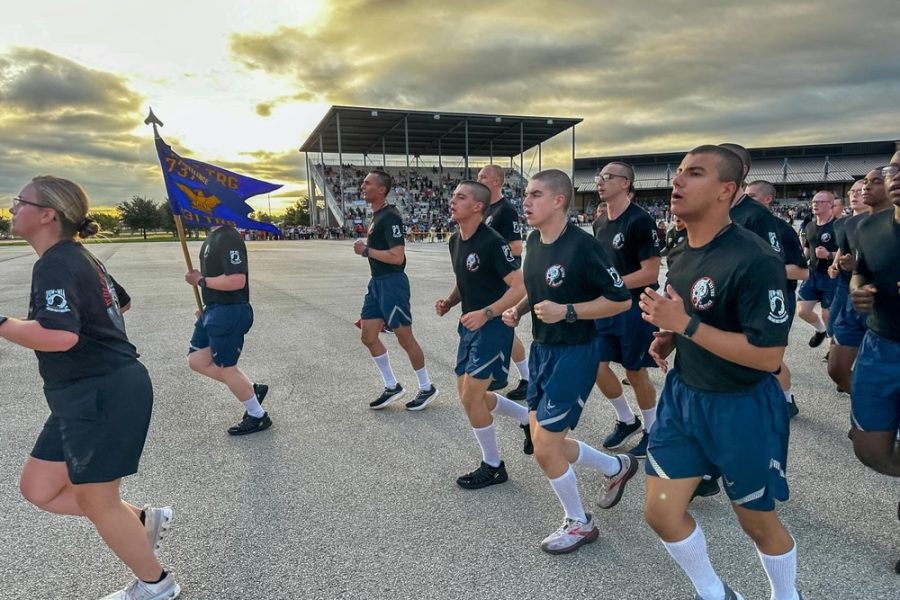Trainees in Basic Military Training and technical school no longer have the option to try alternate PT drills if they fail an initial assessment, according to a policy change the Air Force made in April. The move is part of a larger shift out of the classroom and into hands-on, physically demanding scenarios to prepare Airmen for future conflict, officials said.
“In addition to these changes, the BMT curriculum is undergoing a complete rewrite to incorporate more physical training, focusing on the skills needed to defend, operate, generate, and sustain air and space power,” said Capt. Paige Skinner, a spokesperson for the 2nd Air Force, which runs Air Force enlisted training. The news was first reported by Stars & Stripes.
New recruits in BMT and Airmen in tech school preparing for their specific career field must meet or exceed the Air Force’s minimum standards for a physical fitness test involving pushups, sit-ups, and a 1.5-mile run. Before April, if participants failed to pass a component of the test they could retest using an alternate method and not have to retake the entire test.
For example, if they failed at pushups, they could retest with traditional pushups or with hand-release pushups (where Airmen lower their chest all the way to the ground and extend their hands out to the sides before pushing up again). If they failed at situps, they could retest in that or with the reverse cross leg crunch. If they failed at the 1.5-mile run, they could retest in that or with a 20-meter high-aerobic multi-shuttle run (HAMR).
Today, if trainees fail at any of the components, they must retake the entire test in its original components.
The alternate components were initially authorized in October 2022, as the Air Force was coming back from the COVID-19 pandemic. During the early stages of the pandemic, physical fitness assessments were suspended for about six months as the service developed and implemented modified PT procedures “that would enable the training pipeline to continue operating safely,” Skinner explained.
“The goal was to balance the need to maintain fitness standards with the need to protect trainees from the spread of the virus,” she added.
As pandemic restrictions pulled back, normal fitness standards and procedures were reinstated, but the alternate exercises remained until this April. BMT trainees have to take the physical training test at least three times, during the first, third, and fifth weeks of training.
If trainees fail each of their three chances to pass the test, BMT group commanders review the case to decide whether the trainee will be washed back to another training flight, eliminated from BMT, or, in extraordinary circumstances such as an injury temporarily affecting performance, granted a waiver.
“Trainees are not authorized alternate test components to maintain consistency, standardization, and developmental expectations across the training pipeline,” Skinner explained. “The goal is to establish a common baseline of physical readiness.”
The update is part of a larger batch of changes at BMT. Starting this fall, officials plan to roll out a new curriculum for BMT that will focus on training Airmen and Space Force Guardians in much smaller groups and replace some classroom instruction with a more hands-on learning approach. There could also be more daily PT training and more exercises simulating combat.
“Basically, we’re trying to get our Airmen and Guardians prepared for, if they’re out in a deployed environment, ’Can you pull something? Can you push? Can you put something over your head?” Chief Master Sgt. Whitfield Jack, the senior noncommissioned officer for the 737th Training Group, told Air & Space Forces Magazine in May. “Can you bend down and squat and pick something up?’ … more litter carries and pulling rope and things like that.”
Trainees may find themselves working in 12- to 15-person teams instead of flights of 50 trainees, and they may work out 90 minutes a day rather than just an hour. These changes are themselves part of a larger shift across the Air Force to prepare troops for the physical and mental challenge of a future conflict, which could see Airmen launching and recovering aircraft from small, isolated airfields exposed to enemy attack.
“So it’s about creating that mindset and changing this concept of, ‘well, I’m not the person pulling the trigger, so I’m not really a warrior,’ to ‘what is it that I do that’s going to contribute to our success’ as that basic guiding principle,” Maj. Gen. Wolfe Davidson, who oversees Air Force enlisted training, said in May.
Indeed, Airmen across the force may have to hit the gym more often going forward. Earlier in June, Chief Master Sergeant of the Air Force David A. Flosi told other enlisted leaders that upcoming PT tests may include a two-mile run, and that Airmen may have to take the assessment twice a year rather than once a year. No final decisions have been announced, however.
Flosi told the enlisted leaders that Airmen must be physically fit for combat, which they might face at any time.
“Any day could be the day—that’s what has been on my mind and the focus of your AF leadership this past couple weeks,” he wrote, referencing recent deployments to Europe and the Middle East as part of the U.S. response to rising tensions between Israel and Iran.
